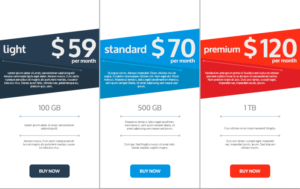
Are Default Options Going to Increase Your Revenue?
October 19, 2016
Create a Sense of Urgency in the Cloud
November 23, 2016Imagine this scenario. Your team has worked extremely hard to bring your latest cloud subscription service to market. Now, you’re walking into a meeting with Product and Marketing, with a goal of devising the final prices for your new service. You’ve done lots of research with target customers and have a pretty good idea of a price range. (Your research suggests somewhere between $18 and $20 would be the best price for your lowest-tier subscription offering.) But how do you come up with that final number that becomes your price? And, how can you support that price with the best call to action? Here we will describe some psychology that will help you in deciding between pricing your product at $20, $18, and $19.99, and in deciding the optimal number of words to use in your call to action.
Tip 1: End Your Price With 9
If you’re deciding between offering your cloud service at $19.99 per month, or $20, go with $19.99.
Why is that?
According to a paper published in Quantitative Marketing and Economics by researchers at MIT and University of Chicago’s Graduate School of Business, the effect is true. A price ending in 9 increases demand. It’s called price-ending effects, and there is a fair amount of research done on the topic. The MIT/Chicago researchers reviewed years of literature on the topic and found several possible theories explaining the effect. Some theories suggested that the price-ending affects the left-most digit, while others suggested its importance is an impact on the rightmost digit:
“The literature contains a range of explanations for price ending effects. These explanations fall into two broad categories. Explanations in the first category posit various reasons for why customers ‘‘drop-off ’’ the right-most digits and therefore overweight the leftmost digits. The most common of these explanations is that customers round prices down (Gabor and Granger, 1964; Lambert, 1975; Schindler and Kibarian, 1993) and essentially ignore the right-most digits. For example $59.99 might be coded as $59 or, in an extreme case, as $50.
A second class of theories posits that price endings provide information about relative price levels and/or product quality (Schindler, 1991). In these theories, customers pay more attention to the rightmost digits because of the information that they convey. This contrasts with the customer’s emphasis on the left-most digits in the ‘‘dropping off ’’ theories. Researchers have suggested that one inference customers may draw from $9-endings is that a price is low, discounted, or on ‘‘Sale’’ (Schindler and Warren, 1988). For example, Salmon and Ortmeyer (1993) describe a department store that uses a 0-cent ending for regularly priced items and 98-cent endings for clearance items.”
After completing their review, the researchers found most convincing evidence for the rightmost digit theory, although it’s not crystal clear, with several studies reporting evidence for the leftmost digit theory. It appears to be context dependent, and it’s clear that there are still gaps in understanding the mechanisms behind price-ending effects. In any case, that shouldn’t stop you from experimenting with achieving price-ending effects.
Implement A Price-Ending of 9 In Your Pricing!
- Price your products with the rightmost digit ending in 9.
- Any other number will not work as well. (There is a gap in the research as to why a price ending with a number other than 9– for example $19.80 or $19.50– would not be as favourable an effect as a price ending in 9.)
- Effects are best for “new items that customers have seen less frequently in the past” (Anderson, Simester, 2003.)
Tip 2: Make Your Call to Action Seven (Plus/Minus 2) Words
You just learned that ending your price in 9 is powerful, and you’ve updated your prices with this principle. Now, how can you support your well-formed pricing with the most engaging call to action? Now it’s time to apply Miller’s Magic Number.
In one of the most highly cited research papers in psychology to date, cognitive psychologist George A. Miller discovered that the maximum amount of elements that humans can store at once is 7,± 2. These “elements” can be letters, digits, or words– and Miller found that 7 seems to be the limit of our capacity for short-term memory. This magic number 7 can also be “stretched”, by categorizing information into related groups. How can you apply Miller’s Magic Number to pricing?
Use The Magic Number in Your Call to Action
Try using it on your call to action, by constraining your copy to Miller’s number– 7± 2 words.
As an example, let’s take a look at Salesforce.com’s Sales Cloud pricing page. Notice how each call to action follows the principle of Miller’s Magic number, and as a result, how easy it is to digest the information. Each call to action uses a limit of 7 ± 2 words, which allows customers to absorb the entire call to action at once. In contrast, let’s examine an instance where Miller’s principle is not followed: take a look at the Dropbox business pricing page. In this example, notice how it seems much harder to process the information here, even though these call to action statements are only a few more words than the Salesforce example.
Use The Magic Number in Your Features List
You can also apply Miller’s principle to the number of bullet points in your features list. This will help you ensure your customers are reading and retaining everything you’ve worked so hard to build them.
This may be challenging in practice, with so many benefits that your team is excited to convey. The point here, is that by constraining your content to manageable chunks, you can get customers to read all of your benefits, rather than overwhelming them with a long list that seems like work to read. To observe this in action, let’s take a look at some examples of companies’ feature lists. First let’s revisit our previous Salesforce example. Notice how this page violates Miller’s principle in its lengthy product descriptions for each tier. How do you feel when reading this? Now, compare it to the company’s Marketing Cloud pricing page, which sticks to Miller’s principle for the benefits of each tier. Notice how the information is much more easy to consume with this offering. This is a great example of how you can design your features list into manageable “chunks” to fit within your customers’ short term memory limits. (Although, the prices are not listed on the website, which we never recommend!)

In the example depicted in this photo, the call to action statements are too wordy. However, the number of items in the features lists do fit within Miller’s principles.
Implement Miller’s Magic Number in Your Pricing Page!
- Craft calls to action that are your best 7 ± 2 words.
- Extend this learning to your product description, with a maximum of 7 ± 2 bullet points to describe each offering.
- Consider other ways to limit your content to chunks following Miller’s principle.
Now, back to our scenario from the beginning. You attend your meeting, eager to share your customer research, and your recommendations to price the new service at $19.99. Your team moves forward with the pricing, as well as a refined call to action statement and feature list. By the end of the meeting, the team has a well-formulated pricing strategy, and an appreciation for considering customers’ psychology for optimal results.
These insights are just an initial starting block for learning lots more about pricing psychology for your business. To get started, try implementing one new idea, and be sure to arrange a plan to test and understand the results. The greatest rewards will come when you continue to tweak and understand how these insights are relevant to your specific business.






